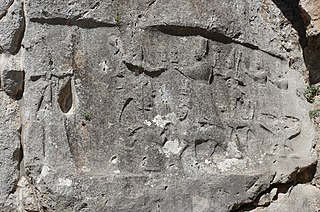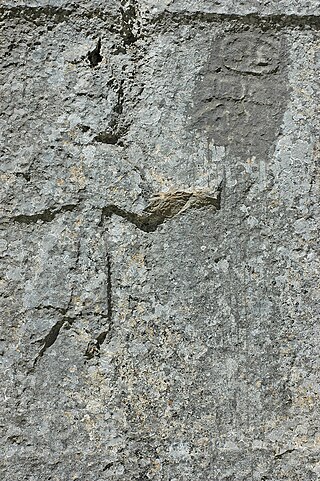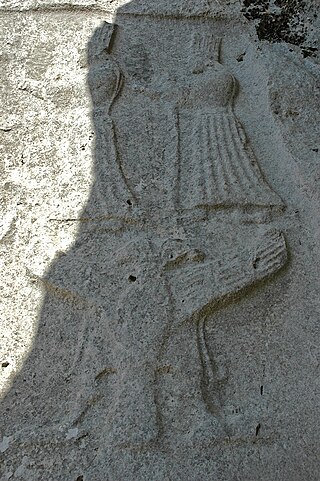Related Research Articles

Ḫebat or Hepat was a Hurrian goddess. She was the tutelary deity of Halab in origin, and in that role appears already in pre-Hurrian texts from Ebla. Her status was not identical in all Hurrian centers: while she was the main goddess in the pantheons of Halab and various cities of Kizzuwatna, her role in Ugarit and in eastern cities like Nuzi was smaller.

Kušuḫ, also known under the name Umbu, was the Hurrian god of the moon. He is attested in cuneiform texts from many sites, from Hattusa in modern Turkey, through Ugarit, Alalakh, Mari and other locations in Syria, to Nuzi, located near modern Kirkuk in Iraq, but known sources do not indicate that he was associated with a single city. His name might be derived from the toponym Kuzina, possibly the Hurrian name of Harran, a city in Upper Mesopotamia, but both this etymology and identification of this sparsely attested place name remain uncertain. He was a popular, commonly worshiped god, and many theophoric names invoking him are known. In addition to serving as a divine representation of the moon, he was also associated with oaths, oracles and pregnancy. Some aspects of his character were likely influenced by his Mesopotamian counterpart Sin, while he in turn was an influence on the Ugaritic god Yarikh and Luwian Arma.

Pinikir, also known as Pinigir, Pirengir and Parakaras, was an Ancient Near Eastern astral goddess who originates in Elamite religious beliefs. While she is only infrequently attested in Elamite documents, she achieved a degree of prominence in Hurrian religion. Due to her presence in pantheons of many parts of the Ancient Near East, from Anatolia to Iran, modern researchers refer to her as a "cosmopolitan deity."

Šauška (Shaushka), also called Šauša or Šawuška, was the highest ranked goddess in the Hurrian pantheon. She wa associated with love and war, as well as with incantations and by extension with healing. While she was usually referred to as a goddess and with feminine titles, such as allai, references to masculine Šauška are also known. The Hurrians associated her with Nineveh, but she was also worshiped in many other centers associated with this culture, from Anatolian cities in Kizzuwatna, through Alalakh and Ugarit in Syria, to Nuzi and Ulamme in northeastern Mesopotamia. She was also worshiped in southern Mesopotamia, where she was introduced alongside a number of other foreign deities in the Ur III period. In this area, she came to be associated with Ishtar. At a later point in time, growing Hurrian influence on Hittite culture resulted in the adoption of Šauška into the Hittite state pantheon.

Allani, also known under the Akkadian name Allatu was the Hurrian goddess of the underworld, incorporated into Hittite and Mesopotamian pantheons as well.

The Hurrian religion was the polytheistic religion of the Hurrians, a Bronze Age people of the Near East who chiefly inhabited the north of the Fertile Crescent. While the oldest evidence goes back to the third millennium BCE, is best attested in cuneiform sources from the second millennium BCE written not only in the Hurrian language, but also Akkadian, Hittite and Ugaritic. It was shaped by the contacts between Hurrians and various cultures they coexisted with. As a result, the Hurrian pantheon included both natively Hurrian deities and those of foreign origin, adopted from Mesopotamian, Syrian, Anatolian and Elamite beliefs. The culture of the Hurrians were not entirely homogeneous, and different local religious traditions are documented in sources from Hurrian kingdoms such as Arrapha, Kizzuwatna and Mitanni, as well as from cities with sizeable Hurrian populations, such as Ugarit and Alalakh.

Šimige was the Hurrian sun god. Known sources do not associate him with any specific location, but he is attested in documents from various settlements inhabited by the Hurrians, from Kizzuwatnean cities in modern Turkey, through Ugarit, Alalakh and Mari in Syria, to Nuzi, in antiquity a part of the kingdom of Arrapha in northeastern Iraq. His character was to a large degree based on his Mesopotamian counterpart Shamash, though they were not identical. Šimige was in turn an influence on the Hittite Sun god of Heaven and Luwian Tiwaz.

Sukkal was a term which could denote both a type of official and a class of deities in ancient Mesopotamia. The historical sukkals were responsible for overseeing the execution of various commands of the kings and acted as diplomatic envoys and translators for foreign dignitaties. The deities referred to as sukkals fulfilled a similar role in mythology, acting as servants, advisors and envoys of the main gods of the Mesopotamian pantheon, such as Enlil or Inanna. The best known sukkal is the goddess Ninshubur. In art, they were depicted carrying staffs, most likely understood as their attribute. They could function as intercessory deities, believed to mediate between worshipers and the major gods.

Belet Nagar was the tutelary goddess of the ancient Syrian city Nagar. She was also worshiped by the Hurrians and in Mesopotamia. She was connected with kingship, but much about her role in the religions of the ancient Near East remains uncertain.

Nupatik, also known as Lubadag, was a Hurrian god of uncertain character. He is attested in the earliest inscriptions from Urkesh, as well as in texts from many other Hurrian settlements, and possibly continued to be worshiped as late as in the neo-Assyrian period. However, his functions remain uncertain.

Nabarbi was a Hurrian goddess worshiped in the proximity of the river Khabur, especially in the city Taite. It has been proposed that she was associated with the Syrian goddess Belet Nagar.
Takitu, Takiti or Daqitu was a Hurrian goddess who served as the sukkal of Ḫepat. She appears alongside her mistress in a number of Hurrian myths, in which she is portrayed as her closest confidante. Her name is usually assumed to have its origin in a Semitic language, though a possible Hurrian etymology has also been proposed. She was worshiped in Hattusa, Lawazantiya and Ugarit.
Tašmišu (Tashmishu) was a Hurrian god. He was regarded as a brother of Teshub, and it is assumed he had a warlike character.
Ammarik, also transcribed as Ammarig or Hammarigu, was a god worshiped in Ebla in the third millennium BCE. He was most likely a deified mountain.

Allanzu, later known under the name Alasuwa, was a Hurrian goddess regarded as a daughter of Ḫepat. She was described as a youthful deity and in known texts often appears in association with her mother and siblings. She was also worshiped by Hittites and Luwians.
Šulinkatte was a Hittite god of Hattian origin. He was regarded as a war deity. Additionally, he could fulfill the role of a protector of palaces and houses. In the local tradition of Nerik, he was regarded as the father of the weather god of Nerik. He first appears in texts dated to the fifteenth or fourteenth century BCE. His main cult center was the sparsely attested city Tamarmara, but he was also worshiped elsewhere in ancient Anatolia, for example in Hattusa and Nerik. Fragments of a Hattic song celebrating him are also known.
Uršui or Uršue was a Hurrian goddess. Her name might be derived from the toponym Uršu. It is not certain if the also attested name Uršui-Iškalli should be interpreted as Uršui's name being used as an epithet, as her name accompanied by epithet, or as a pair of goddesses. In Hurrian offering lists, appears as a member of the circle of either Ḫepat or Šauška.
Wurunkatte or Wurukatte was a Hittite war god of Hattian origin. He might have also been connected to the institution of kingship. His symbol was a mace, and based on textual sources it is presumed he could be depicted standing on the back of a lion. In known texts, he appears in association with deities such as Šulinkatte, Taru and Telipinu. He was worshiped in Hattusa, Nerik, Tuḫumijara and Tarammeka.
Šeri and Ḫurri were a pair of theriomorphic Hurrian gods who almost always appear together in known sources. They were believed to pull the chariot of Teššub, the Hurrian weather god. Šeri additionally could function as a deity mediating between petitioners and his master, but no individual role was ever assigned to Ḫurri. In addition to appearing in Hurrian offering lists and theophoric names, for example from Nuzi, Šeri and Ḫurri are also attested in Hittite and Mesopotamian sources. While the Hittites incorporated them into their pantheon alongside Teššub and other deities from his circle, in Mesopotamia they instead came to be associated with Adad.
References
- 1 2 3 4 Kammenhuber 1972, p. 369.
- 1 2 Archi 2004, p. 330.
- 1 2 Astour 1987, p. 27.
- 1 2 Haas 2015, p. 170.
- 1 2 3 4 5 6 Schwemer 2022, p. 379.
- 1 2 3 4 5 Kammenhuber 1972, p. 370.
- ↑ Haas 2015, p. 333.
- ↑ Haas 2015, p. 459.
- 1 2 Taracha 2009, p. 95.
- 1 2 Haas 2015, p. 364.
- ↑ Wilhelm 1987, p. 173.
- ↑ Haas 1972, p. 501.
Bibliography
- Archi, Alfonso (2004). "Translation of Gods: Kumarpi, Enlil, Dagan/NISABA, Ḫalki". Orientalia. GBPress - Gregorian Biblical Press. 73 (4): 319–336. ISSN 0030-5367. JSTOR 43078173 . Retrieved 2022-06-25.
- Astour, Michael C. (1987). "Semites and Hurrians in Northern Transtigris". General studies and excavations at Nuzi 9/1. Winona Lake, Ind.: Eisenbrauns. ISBN 0-931464-37-4. OCLC 23115188 . Retrieved 2022-06-25.
- Haas, Volkert (1972), "Ḫupuštukar", Reallexikon der Assyriologie (in German), retrieved 2022-06-25
- Haas, Volkert (2015). Geschichte der hethitischen Religion. Handbook of Oriental Studies. Section 1: The Near and Middle East (in German). Brill. ISBN 978-90-04-29394-6 . Retrieved 2022-06-25.
- Kammenhuber, Annelies (1972), "Ḫešui, Ḫišue", Reallexikon der Assyriologie (in German), retrieved 2022-06-25
- Schwemer, Daniel (2022). "Religion and Power". Handbook of Hittite Empire. De Gruyter. pp. 355–418. doi:10.1515/9783110661781-009. ISBN 9783110661781.
- Taracha, Piotr (2009). Religions of Second Millennium Anatolia. Harrassowitz. ISBN 978-3447058858.
- Wilhelm, Gernot (1987), "Lupatik, Nupatik", Reallexikon der Assyriologie (in German), retrieved 2022-06-25